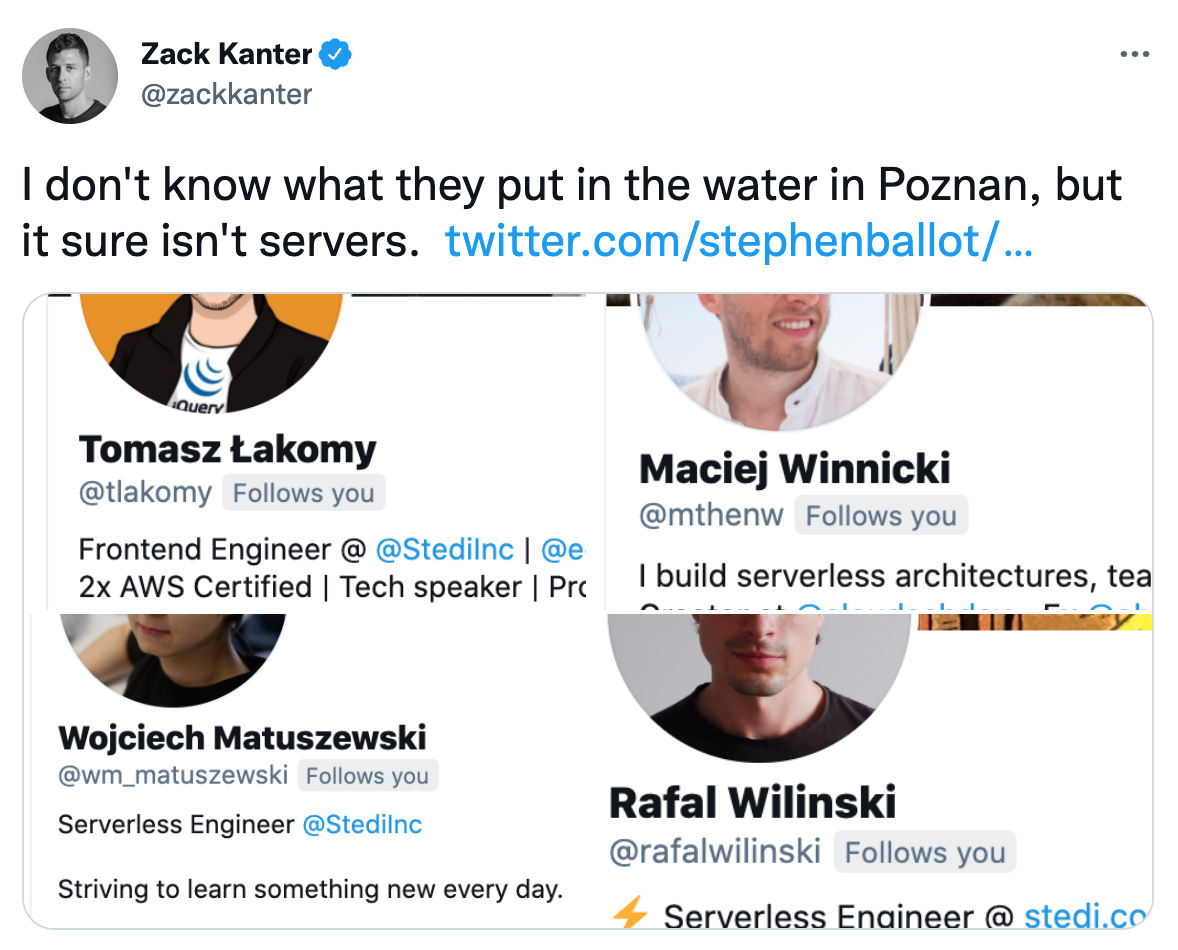What they put in the water

Other than “robot clams,” Poznań (the city where I live) is not a particularly special place by any objective measure — and I say this with all the love in the world.
Sure, it’s a special place to me — it’s my home, I’ve been living here for 9 years now: my kids were born here, we have friends here, we know where to shop, we know where the good restaurants are, we live happily and comfortably. But objectively speaking: Poznań is anything but a second Silicon Valley — not of the world, not of Europe, not even of Poland. With a population of about half a million people it’s not particularly big. It’s not particularly rich either — financially Poland is on the rise, but still behind on the “west.” Overall the trend is for Polish people to move out, not for foreigners to move in. Poznań does have two universities with decent computer science programs, but nothing particularly spectacular (as far as I’m aware). The majority of software companies here are outsourcing companies with western customers. There are a few product companies, but you can probably count them on one hand.
With this in mind, when I moved here 9 years ago, the first three years I worked remotely for Dutch and US companies. I’m not a big risk taker, and with somewhat of a network in place back home, taking a remote job seemed like the right way to go.
During those first three “remote years” I had the opportunity to work with great people with all kinds of diverse backgrounds, ranging from people that had worked at Apple, Google, Amazon; people that had no formal education at all, those that had gone to famous universities (Stanford, Harvard) with PhDs, as well as former professors; people from nations all around: US, Canada, India, China, Australia, Brazil, Italy, Spain, Germany, Russia.
Then, when after those three years, I decided to give working for companies in Poznań a try, my expectations weren’t particularly high. Compared to previous companies where the talent pool was the world, it was likely all downhill from there, right?
But it wasn’t.
Over the last 6 or so years I’ve worked for 3 different companies in Poznań. One outsourcing company, one product company with the head-office in the Bay Area and engineering office in Poznań, and one product company that has tech hubs all over the world (with three in Europe), but with the largest business here in Poland.
In every single one of them I’ve found world-class people with tons of potential. Sometimes that potential had flourished to some local level. I’ve seen some crazy impressive technical solutions to tough problems. I’ve been to local meetups where people showed mind-blowing things. But you’ll likely never have seen or experienced much of that. There was potential, but somehow… it rarely made it to the world stage.
Why?
My theory: the environment wasn't there — as hobby-horse-y as that may sound.
Why do (or did, pre-pandemic) so many engineers and entrepreneurs move to Silicon Valley? I’ve spent time there. The water is terrible, for sure that’s not it. So what then?
Indeed: the nurturing environment.
Not the nature (although a lot of California is unfairly beautiful) — the companies, the people, the start-up infrastructure. This is where you go to attempt to launch the next big thing, this is where all the action is, this is where you can learn so much stuff, this is where some get rich.
The success of Silicon Valley and the fact that it exists in the Bay Area can be explained by a mix of historical and environmental factors. Can this not be replicated elsewhere? Theoretically it can, and many cities attempt to do so by actively trying to cultivate a similar environment in their location of choice. Various cities in Europe aim to become “the Silicon Valley of Europe.” None have taken over (so far), but they try.
But we don’t have to wait for our governments to build the next Silicon Valley in our backyard. We can attempt to create micro-environments essentially anywhere. Like… in Poznań. Why not? I hear the water is pretty nice there. Robot clams.
The tweet we started out with is from the CEO of Stedi, a company that has been successfully attracting some of the who's-who in the Serverless world. They ended up with 4 people from this small city in Poland. How did that happen?
I happen to know three of these guys reasonably well and was a participant in their journey over the last years. They all worked in my group at OLX. Therefore, I feel somewhat qualified to give my interpretation of the “making of.” At the start of the journey one was a principal engineer at serverless (so that one you could’ve seen coming), one was a front-end engineer specialized in jQuery, and another was a computer science student looking for an internship. At the end they are all serverless engineers at Stedi.
Clearly, something went both very well, and terribly wrong.
As painful as it is, this is one of the best things that can happen in your career: you know you’re on to something, at the same time there’s sufficient failure to learn from.
Let me start with the on-to-something aspect: here’s my inferred ultimate recipe for management success. Not to be hyperbolic or anything.
Here goes:
- Create an attractive environment that has a clear vision and direction, but leaves ample autonomy.
- Recruit a few key players into this environment — key players that can attract more talent into the group, but perhaps more importantly: excel at pulling other people up to their level (and potentially beyond).
- Sustain it: do whatever in your power to let this environment keep up with the group’s growth.
Usually people conveniently forget to mention that knowing a recipe is one thing, executing it successfully is a whole different story.
This is one of those cases.
Therefore at this point I have to admit that there may be a step (4), but as you will have figured out by now — (1) and (2) of this process worked quite well, but ultimately (3) was a tough one — which is why these guys now work at Stedi (so maybe they at some point they will tell me what step 4 is, if any).
Here’s some of the back story.
My part of their journey started when I joined OLX Group almost 3 years ago. I myself joined because it offered (1) — the attractive environment. The concept was: we are a stable corporation, we have the resources, and we want to attempt to bootstrap a new product in a start-up like environment — it’s greenfield, with few constrains, pick your technology stack, we have a product concept that still needs validation, but you are pretty much autonomous. This environmental setup was created by a mix of business, product and tech leaders are the time who deserve a lot of credit. This is what planted the seed. “(1) Create an attractive environment.” ✅
Tomek (the jQuery guy) was the first to be recruited (but had to quit on me in our previous company first, as he had done the company before — it’s our tradition). I was quickly recruited thereafter as his engineering manager. To test the “how far can I push autonomy” waters, during my interview process I asked the CTO the question “If I were to say ‘I’d like to build everything on AWS lambda,’ how would you respond?” His answer was “then I would say ‘you’re hired.’” “(2) Recruit a few key players into this environment.” ✅
And so we started. We had limited engineering power to reinvent anything, and limited support in terms of infrastructure. This AWS Lambda and serverless thing may not have been as much as an out there idea as I had intended it to be during my interview. I vaguely remembered that one other guy (Maciej) I had once been in touch with in Poznań happened to work at Serverless Inc., so I invited him for lunch. “Sure,” he told me, “given your use case, I see no reason why you shouldn’t go fully serverless.”
So we did. ”(1 continued) …but leaves ample autonomy.” ✅
Lacking any backend engineers or significant infrastructure help, I built the first version of our backend and infrastructure myself. The general back-end direction for the company at that time was Go, and I complemented that with various AWS serverless offerings. This stack would later be dubbed the GoLD stack. I encouraged my team members to overstep their (jQuery) boundaries and help out too, owning everything end-to-end. In the mean time we recruited internal and external people with back-end skills superior to mine. I found out Maciej (still at Serverless) had management ambitions, so when I got promoted myself, I recruited him to replace me in my former role. “(2) Recruit a few key players into this environment…” (generation 2) ✅
Things went quickly from there. We attempted to create an environment where knowledge exchange was the default so people would speak at internal events, organize workshops, tweet, blog and speak at conferences. Many did and were quite successful at it. Maciej hired two more high-potential engineers, one as an intern. “(2 continued) …that can attract more talent into the group…” ✅
He then proceeded to systematically pull them up: “ok, so you’ve shown you can do front-end, how about back-end, now how about an AWS certification, now how about…” Wherever the goalposts were put, these guys went. Practically all members of this team grew significantly during this time. Partially this was due to talent, but also largely because they were given the push, space and opportunity to do so (a.k.a. “management”). ”(2 continued) …but perhaps more importantly, excel at pulling other people up to their level (and potentially beyond).” ✅
Now, this is where you’re challenged as a manager and company. Can you keep up the pace when this happens? Can you offer the right opportunities for career growth, impact, compensation? “(3) Sustain it: do whatever in your power to let this environment keep up with the group’s growth.”
Even thought this didn’t end amazingly well (for us), that only makes it a better source for learning. What it showed me is the impact good environments can have. Definitely, you need to find the right people, but that will only get you so far. “Nurture” is key and perhaps more important than “nature.”
This is why the Poznań angle is relevant: if it can happen here, it can happen anywhere. Therefore, perhaps as a viable alternative to roaming the world to find those few “10x engineers,” you may instead decide to spend your time investing in creating the right environment for the people (virtually) sitting right in front of you. Once it’s in place, it may just grow by itself and expand into your own little Silicon Valley (if you can sustain it long enough).
There is nothing in the water in Poznań. The raw material is the same everywhere, it just requires filtering, processing and enrichment. It just requires management.
“Just.”

